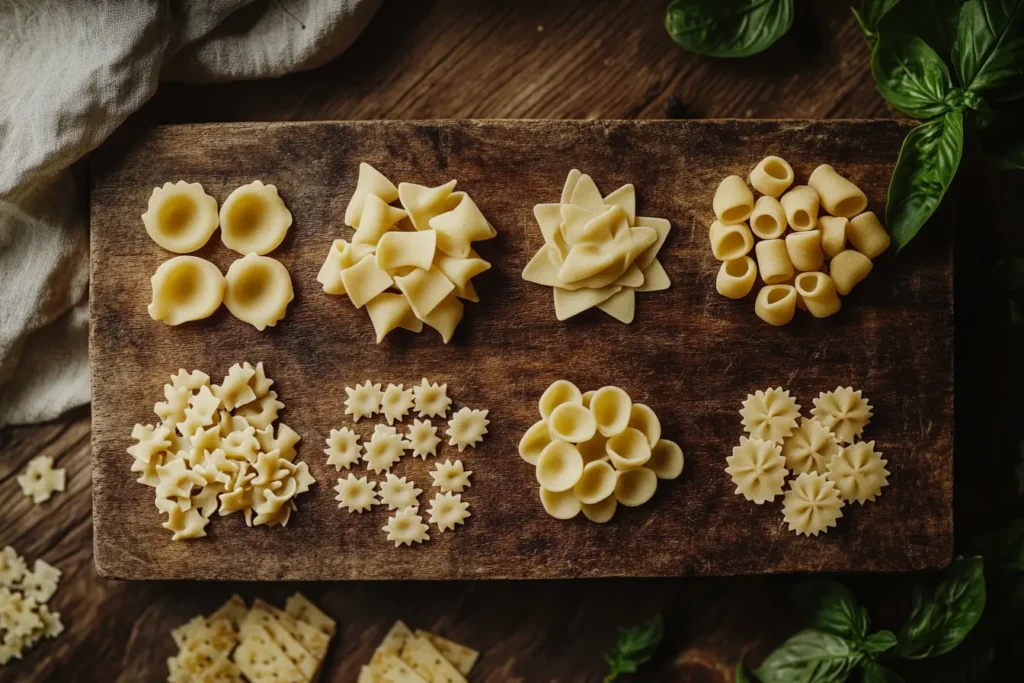Every Sunday, I stood beside my Nonna Emilia as we made pasta e fagioli together. She always chose ditalini—those tiny, tube-shaped pasta—and as the soup simmered, she would share stories of her childhood in Italy. The rich aroma filled her warm, inviting kitchen, blending with the soothing cadence of her voice. Ditalini was the heart of the dish, its small shape perfect for soaking up every drop of the flavorful broth.
So, when Lily and Mia requested pasta e fagioli last week, I knew I had to deliver. But as I rummaged through my pantry, I realized I was out of ditalini! Panic momentarily set in, but then my Nonna’s adventurous spirit inspired me. I decided to explore what is the closest pasta to ditalini so I could still make their favorite soup.
This journey of discovery led to some fun kitchen experiments. I tried different small pasta shapes, noting their textures and how they absorbed the broth. It gave me a deeper appreciation for the nuances of pasta and how each shape contributes to a dish. I even got Lily and Mia involved in the taste tests!
I’m excited to share what I learned. I’ll offer some delicious ditalini alternatives you can use in a pinch. Whether you’re making soup, salad, or another pasta dish, these substitutes will ensure your meal is still a success.

Understanding Ditalini Pasta
What is this type of pasta?
Ditalini is a type of small pasta. Its name comes from the Italian word “ditale,” meaning “thimble.” And if you look closely, you’ll see why! These tiny tubes of pasta resemble miniature thimbles. They are typically about 1/2 inch long, much smaller than most other pasta shapes. In Italy, ditalini is often used in soups like minestrone and pasta e fagioli, but it also works well in salads and other pasta dishes.
Why it is so Popular in Soups and Salads?
Its small size and tubular shape make it a perfect choice for soups and salads. In soups, the tubes capture and hold the flavorful broth. Each spoonful delivers a burst of flavor, along with the satisfying texture of the pasta. Because ditalini is small, it cooks quickly and distributes evenly throughout the soup, ensuring every bite is delicious.
Similarly, in salads, ditalini’s size allows it to mix well with other ingredients. The tubes also hold onto dressings beautifully, preventing them from pooling at the bottom of the bowl. Whether it’s a light vinaigrette or a creamy dressing, ditalini ensures every piece is coated in delicious flavor. Its smooth surface also provides a pleasant contrast to crunchy vegetables and other salad components.
Top 5 Substitutes
1. Tubettini
Tubettini is the closest you’ll get to ditalini. It’s also a small tube-shaped pasta, just slightly longer. I often find myself reaching for tubettini when I’m out of other types, and it works perfectly in soups, salads, and any other dish that calls for pasta. It cooks in about the same amount of time and has a similar texture, absorbing broth and holding onto dressings just as well.
Simple Tubettini Salad: Cook tubettini according to package directions. Toss with chopped cherry tomatoes, cucumbers, olives, feta cheese, and a simple vinaigrette.
2. Small Elbow Macaroni
Small elbow macaroni is another great substitute. While it’s not a tube, its curved shape and small size make it a good stand-in. I like using small elbow macaroni in pasta salads, especially when I want a slightly chewier texture. Keep in mind that it might absorb a little more liquid than ditalini, so you may need to adjust the amount of broth or dressing in your recipe.
Simple Macaroni and Cheese: Cook small elbow macaroni according to package directions. Mix with your favorite cheese sauce and bake until bubbly.
3. Orzo
Orzo is a small, rice-shaped pasta. While it’s not a tube, its size and ability to absorb liquid make it a viable alternative. I find orzo works particularly well in soups and salads with lighter broths or dressings. It has a slightly different texture than ditalini, a little more tender and less chewy. Orzo cooks quickly, so keep an eye on it to avoid overcooking.

Simple Orzo Salad: Cook orzo according to package directions. Toss with chopped fresh herbs, lemon juice, olive oil, and crumbled feta cheese.
4. Anellini
Anellini is a tiny ring-shaped pasta. It’s smaller than ditalini but can still be a fun and tasty substitute. The rings add a unique visual appeal to dishes, and their delicate texture works well in brothy soups. I enjoy using anellini when I want a more delicate texture in my soup. Because it’s so small, it cooks very quickly.
Simple Anellini Soup: Add anellini to your favorite vegetable broth during the last few minutes of cooking.
5. Acini di Pepe
Acini di pepe means “peppercorns” in Italian, and that’s exactly what this pasta looks like – tiny, round grains. While significantly smaller than ditalini, acini di pepe can still add a pleasant texture to soups, especially those with delicate flavors. I like using it in creamy soups where its small size won’t overpower other ingredients. It cooks very quickly, so be careful not to overcook it.
Simple Acini di Pepe in Brothy Soup: Add acini di pepe to your favorite chicken broth with some vegetables during the last few minutes of cooking.

Tips for Substituting Pasta Shapes
Cooking Time Adjustments
When substituting pasta shapes, especially when swapping ditalini for something else, it’s important to adjust the cooking time. Different shapes and sizes cook at different rates. I always recommend checking the package directions for the specific pasta you’re using. Start checking for doneness a minute or two before the suggested time. You want the pasta to be al dente – cooked through but still slightly firm to the bite. Overcooked pasta can become mushy and lose its appeal.
Texture Considerations
The shape of your pasta can significantly impact the texture of your dish. Ditalini’s small tubes offer a pleasant chewiness and hold onto broth well. If you use orzo, you’ll get a more tender, almost creamy texture. Small elbow macaroni will give you a heartier, chewier bite. I encourage you to think about the overall texture you want in your dish when choosing a ditalini substitute. For a soup where you want the pasta to be the star, tubettini or small elbow macaroni might be good choices. For a more delicate soup, orzo or acini di pepe might be better suited. Don’t be afraid to experiment!
FAQ
Is salad macaroni and ditalini the same?
No, salad macaroni and ditalini are not the same. Salad macaroni is a larger, curved tube, often used in, well, salads! Ditalini is much smaller, like tiny thimbles. While you can use salad macaroni in a pinch, it won’t have the same delicate texture or ability to capture broth like ditalini.
Can you substitute ditalini for orzo?
Yes, you can sometimes substitute ditalini for orzo, but they aren’t identical. Ditalini is a small tube, while orzo is rice-shaped. Orzo has a softer, less chewy texture than ditalini. It will work in many dishes, but the final result might be slightly different.
What type of pasta is ditalini?
Ditalini is a small, tube-shaped pasta. The name means “small thimbles” in Italian because of their shape. It’s a type of short-cut pasta, ideal for soups, salads, and other dishes where its small size is an advantage.
Is ditalini pasta the same as acini di pepe?
No, ditalini and acini di pepe are different. Ditalini are small tubes, while acini di pepe are tiny, round beads, even smaller than ditalini. Acini di pepe means “peppercorns,” and they look just like that! While they can sometimes be used interchangeably, their textures will differ in a dish.
Finding the closest pasta to ditalini turned into a fun adventure! It opened my eyes to new possibilities in the kitchen. That day, while I made a delicious pasta e fagioli for Lily and Mia (using tubettini!), I also discovered the joy of experimenting with different pasta shapes. My twins loved helping me taste-test the different options, and it turned into a fun family activity.
This experience expanded my culinary horizons, too. While ditalini holds a special place in my heart, thanks to Nonna Emilia, I now have a whole arsenal of tiny pasta options. Knowing which pasta shapes work well as substitutes gives me more flexibility when I’m cooking.
I encourage you to try these ditalini substitutes in your own kitchen. Don’t be afraid to get creative and experiment with different shapes and textures. You might just find a new favorite! Cooking should be an adventure, and sometimes, a little improvisation leads to the best discoveries.

